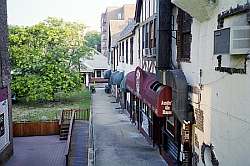Back
Home
Email Me
About Me
Read Guestbook
Guestbook Archives
Sign Guestbook
Where Are They?
What's New
Find It
Need It
Links
Books
Your Old Photos
1920's Map
Current Map

Back | Cont'd

The mews behind Austin Street. After his second attack on Kitty in a hallway at the far end of the 2 story Tudor building on the right, the killer made his escape along this walkway up to Lefferts Boulevard. The Long Island Railroad Stationhouse is in the center of the picture, and beyond that is the West Virginia Apartment House (today called the Austin Arms).
"The killing of Kitty Genovese was a tragedy. But maybe that tragedy was more private and less public than has been suggested by some police officers and some reporters - and it should be noted that both groups had something to gain from the way they told the tale."
Supporting View
Wikipedia Article on Kitty Genovese
Contrary Views
To read a critique by another web site that disagrees with my conclusions, go to:
Jeff Saltzman, Kitty Genovese And the Shame of Kew Gardens, Queens - 40 Years After the Murder That Didn't Have to Be (2004).
For a more traditional take on the Kitty Genovese story, go to:
Crime Library - A Cry in the Night: The Kitty Genovese Murder, by Mark Gado (2004).
Times Article Analyzed
Click here to read the March 27, 1964 New York Times article that first broke the story, along with a paragraph by paragraph analysis of why I think the Times got the story wrong.
Disclaimer
Throughout this page, I will cite to various media accounts of the case. I do so only for the factual statements they contain and not because the authors of those accounts agree with the opinions I express here.
In the Public Domain
My thoughts, comments and opinions about this case along with all images created by or for me are dedicated to the public domain. They may be copied and used without credit or compensation to me. I claim no rights in the trial transcript and briefs included here.
This page was created on January 14 2004.
The Murder of Kitty Genovese:
Doubts
| "What kind of story is this? It doesn't fit together." [Footnote L-1.] |
In 1984, New York Daily News crime reporter, John Melia, revisited the Kitty Genovese case in an article for the paper's Queens Edition. Here are excerpts from that article which was entitled "Stigma from Genovese case remains". [Footnote L-2.]
"Then we started to hear rumblings - rumblings from reporters who had covered the murder of Kitty Genovese and the trial of Winston Moseley discounting the claims that 39 otherwise ordinary and law-abiding citizens watched a slaughter and did nothing.
We heard a story of one reporter, sent out by his editor to find these witnesses, who came back literally begging that the story not run because there was nothing there. He told his editor that the witnesses did not exist in the numbers claimed. But it was too late, the people of Austin Street in Kew Gardens had been stamped with the indelible mark of Cain - the story ran, full of the appropriate outrage and horror.
* * * In retracing the final steps of Kitty Genovese, we began to have doubts, too, as to the number of people who saw something that night. Did the people of Kew Gardens get a bad rap when Kitty Genovese was killed? We have our doubts. You decide."
What has made the Kitty Genovese story resonate over 4 decades are the very aspects of it that appear to have been so badly exaggerated: that 38 people reportedly watched or listened for a full 30 minutes and - seeing or knowing that a woman was stabbed to death, - refused to call the police because they did not want to get involved. As far as I can tell, that scenario did not take place.
Could the residents of Austin Street have reacted better than they did that night? Of course they could have. Anytime humans are involved in anything, the answer to the question, "Could they have done better?", will always be "Yes". The real issue is whether the witnesses' response fell so far short of perfection as to be worthy of the kind of attention and condemnation that they have drawn for over four decades. I don't think it did. For all these years, the 38 witnesses have been portrayed as freaks who displayed a depraved indifference to human life and suffering. If my take on the case is correct, then the truth is far less sensational. At worst, they were just 38 ordinary people who fumbled.
UPDATE (02/03/06): The killer, Winston Moseley, has now been denied parole for the twelfth time since 1984. He is next up for parole in January of 2008. You can track him by clicking on the following link to the New York State Corrections web site and typing "Winston" and "Moseley" (without the quotation marks) in the appropriate text search boxes.
New York State Dept. of Correctional Services
Click here to read a detailed analysis of the
March 27, 1964 New York Times article that broke the story.
| Footnotes |
Footnote L-1: A quote I've taken out of context from: A. M. Rosenthal, Thirty-Eight Witnesses: The Kitty Genovese Case., Part 1, p. 19 (Berkeley : Univ. of Calif. Press 1999). Click here and scroll down to p. 19 to read this book on another web site. Close out window to return here.
Footnote L-2: John Melia, "Stigma remains from Genovese case", The New York Daily News, col. 3 (Queens Edition) (Month and day not known, 1984). [PDF - 231 KB]
Footnote L-3: John Melia and Don Singleton, "Kitty's death still haunts us", The New York Daily News, p. 23 (March 11, 1984).